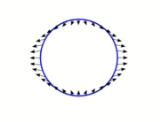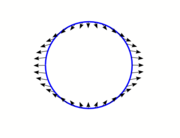
Spaghettification
Encyclopedia

Astrophysics
Astrophysics is the branch of astronomy that deals with the physics of the universe, including the physical properties of celestial objects, as well as their interactions and behavior...
, spaghettification (sometimes referred to as the noodle effect) is the vertical stretching and horizontal compression of objects into long thin shapes (rather like spaghetti
Spaghetti
Spaghetti is a long, thin, cylindrical pasta of Italian origin. Spaghetti is made of semolina or flour and water. Italian dried spaghetti is made from durum wheat semolina, but outside of Italy it may be made with other kinds of flour...
) in a very strong gravitational field, and is caused by extreme tidal forces. In the most extreme cases, near black hole
Black hole
A black hole is a region of spacetime from which nothing, not even light, can escape. The theory of general relativity predicts that a sufficiently compact mass will deform spacetime to form a black hole. Around a black hole there is a mathematically defined surface called an event horizon that...
s, the stretching is so powerful that no object can withstand it, no matter how strong its components. Within a small region the horizontal compression balances the vertical stretching so that small objects being spaghettified experience no net change in volume.
In his book A Brief History of Time
A Brief History of Time
A Brief History of Time is a popular science book written by renown physicist Stephen Hawking and first published by the Bantam Dell Publishing Group in 1988. It became a best-seller and has sold more than 10 million copies...
(1988), Stephen Hawking
Stephen Hawking
Stephen William Hawking, CH, CBE, FRS, FRSA is an English theoretical physicist and cosmologist, whose scientific books and public appearances have made him an academic celebrity...
describes the flight of a fictional astronaut
Astronaut
An astronaut or cosmonaut is a person trained by a human spaceflight program to command, pilot, or serve as a crew member of a spacecraft....
who, passing within a black hole's event horizon
Event horizon
In general relativity, an event horizon is a boundary in spacetime beyond which events cannot affect an outside observer. In layman's terms it is defined as "the point of no return" i.e. the point at which the gravitational pull becomes so great as to make escape impossible. The most common case...
, is "stretched like spaghetti" by the gravitational gradient (difference in strength) from head to toe. However, the term "spaghettification" was established well before this; Nigel Calder
Nigel Calder
Nigel Calder is a British science writer.Between 1956 and 1966, Calder wrote for the magazine New Scientist, serving as editor from 1962 until 1966...
, for example, uses it in his book The Key to the Universe: A Report on the New Physics (Viking Press, 1977), a companion to a one-off BBC
BBC
The British Broadcasting Corporation is a British public service broadcaster. Its headquarters is at Broadcasting House in the City of Westminster, London. It is the largest broadcaster in the world, with about 23,000 staff...
TV documentary: The Key to the Universe.
A simple example
The four objects follow the lines of the gravitoelectric field, directed towards the celestial body's centre. In accordance with the inverse-square lawInverse-square law
In physics, an inverse-square law is any physical law stating that a specified physical quantity or strength is inversely proportional to the square of the distance from the source of that physical quantity....
, the lowest of the four objects experiences the biggest gravitational acceleration, so that the whole formation becomes stretched into a filament. Now imagine that the green blobs in the diagram are parts of a larger object. A rigid object will resist distortion—internal elastic forces develop as the body distorts to balance the tidal forces, so attaining mechanical equilibrium. If the tidal forces are too large, the body may yield and flow plastically before the tidal forces can be balanced, or fracture.
Examples of weak and strong tidal forces
In the gravity field due to a point mass or spherical mass, for a uniform rope or rod oriented in the direction of gravity, the tensile force at the center is found by integration of the tidal force (see magnitude of tidal force) from the center to one of the ends. This gives , where
, where  is the standard gravitational parameter
is the standard gravitational parameterStandard gravitational parameter
In astrodynamics, the standard gravitational parameter μ of a celestial body is the product of the gravitational constant G and the mass M of the body.\mu=GM \ The SI units of the standard gravitational parameter are m3s−2....
of the massive body, l is the length of the rope or rod, m is its mass, and r is the distance to the massive body. For non-uniform objects the tensile force is smaller if more mass is near the center, and up to twice as large if more mass is at the ends. In addition there is a horizontal compressive force toward the center.
For massive bodies with a surface the tensile force is largest near the surface, and this maximum value is only dependent on the object and the average density of the massive body (as long as the object is small relative to the massive body). For example, for a rope with a mass of 1 kg and a length of 1 m, and a massive body with the average density of the Earth, this maximum tensile force due to the tidal force is only 0.4 μN.
Due to the high density the tidal force near the surface of a white dwarf
White dwarf
A white dwarf, also called a degenerate dwarf, is a small star composed mostly of electron-degenerate matter. They are very dense; a white dwarf's mass is comparable to that of the Sun and its volume is comparable to that of the Earth. Its faint luminosity comes from the emission of stored...
is much stronger, causing in the example a maximum tensile force of up to 0.24 N. Near a neutron star
Neutron star
A neutron star is a type of stellar remnant that can result from the gravitational collapse of a massive star during a Type II, Type Ib or Type Ic supernova event. Such stars are composed almost entirely of neutrons, which are subatomic particles without electrical charge and with a slightly larger...
the tidal forces are again much stronger: if the rope has a tensile strength of 10,000 N and falls vertically to a neutron star of 2.1 solar masses, setting aside that it would melt, it would break at a distance of 190 km from the center, well above the surface (the typical radius is about 12 km).
While in the previous case objects would actually be destroyed and people killed by the heat, not the tidal forces, near a black hole
Black hole
A black hole is a region of spacetime from which nothing, not even light, can escape. The theory of general relativity predicts that a sufficiently compact mass will deform spacetime to form a black hole. Around a black hole there is a mathematically defined surface called an event horizon that...
(assuming that there is no nearby matter) objects would actually be destroyed and people killed by the tidal forces, because there is no radiation. Moreover, a black hole has no surface to stop a fall. As an object falls into a black hole, the tidal forces increase to infinity, so nothing can resist them. Thus, the infalling object is stretched into a thin strip of matter. Close to the singularity
Gravitational singularity
A gravitational singularity or spacetime singularity is a location where the quantities that are used to measure the gravitational field become infinite in a way that does not depend on the coordinate system...
the tidal forces even tear apart molecules.
Inside or outside the event horizon
The point at which tidal forces destroy an object or kill a person depends on the black hole's size. For a supermassive black holeSupermassive black hole
A supermassive black hole is the largest type of black hole in a galaxy, in the order of hundreds of thousands to billions of solar masses. Most, and possibly all galaxies, including the Milky Way, are believed to contain supermassive black holes at their centers.Supermassive black holes have...
, such as those found at a galaxy's center, this point lies within the event horizon
Event horizon
In general relativity, an event horizon is a boundary in spacetime beyond which events cannot affect an outside observer. In layman's terms it is defined as "the point of no return" i.e. the point at which the gravitational pull becomes so great as to make escape impossible. The most common case...
, so an astronaut may cross the event horizon without noticing any squashing and pulling (although it's only a matter of time, because once inside an event horizon, falling towards the center is inevitable). For small black holes whose Schwarzschild radius
Schwarzschild radius
The Schwarzschild radius is the distance from the center of an object such that, if all the mass of the object were compressed within that sphere, the escape speed from the surface would equal the speed of light...
is much closer to the singularity, the tidal forces would kill even before the astronaut reaches the event horizon. For example, for a black hole of 10 Sun masses and the above-mentioned rope at 1000 km distance, the tensile force halfway the rope is 325 N. It will break at a distance of 320 km, well outside the Schwarzschild radius of 30 km. For a black hole of 10,000 Sun masses it will break at a distance of 3200 km, well inside the Schwarzschild radius of 30,000 km.

